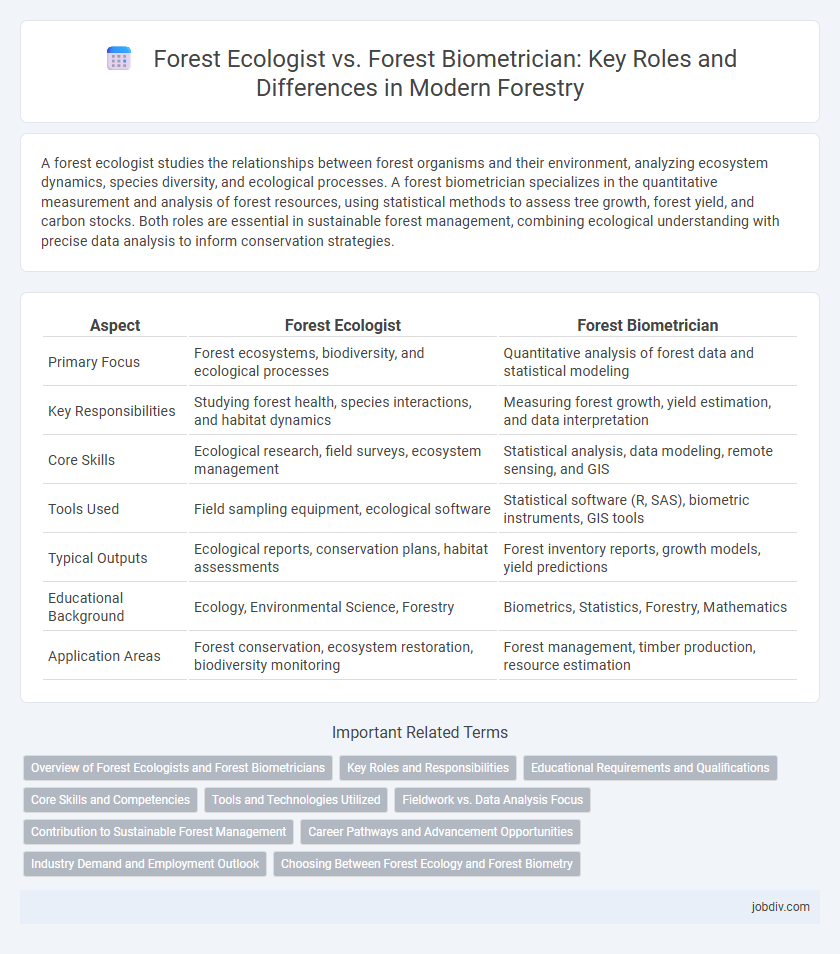A forest ecologist studies the relationships between forest organisms and their environment, analyzing ecosystem dynamics, species diversity, and ecological processes. A forest biometrician specializes in the quantitative measurement and analysis of forest resources, using statistical methods to assess tree growth, forest yield, and carbon stocks. Both roles are essential in sustainable forest management, combining ecological understanding with precise data analysis to inform conservation strategies.
Table of Comparison
| Aspect | Forest Ecologist | Forest Biometrician |
|---|---|---|
| Primary Focus | Forest ecosystems, biodiversity, and ecological processes | Quantitative analysis of forest data and statistical modeling |
| Key Responsibilities | Studying forest health, species interactions, and habitat dynamics | Measuring forest growth, yield estimation, and data interpretation |
| Core Skills | Ecological research, field surveys, ecosystem management | Statistical analysis, data modeling, remote sensing, and GIS |
| Tools Used | Field sampling equipment, ecological software | Statistical software (R, SAS), biometric instruments, GIS tools |
| Typical Outputs | Ecological reports, conservation plans, habitat assessments | Forest inventory reports, growth models, yield predictions |
| Educational Background | Ecology, Environmental Science, Forestry | Biometrics, Statistics, Forestry, Mathematics |
| Application Areas | Forest conservation, ecosystem restoration, biodiversity monitoring | Forest management, timber production, resource estimation |
Overview of Forest Ecologists and Forest Biometricians
Forest ecologists study the complex relationships between forest organisms and their environment, focusing on ecosystem dynamics, biodiversity, and the effects of natural and human disturbances. Forest biometricians specialize in quantitative analysis, using statistical and mathematical models to measure forest growth, yield, and spatial patterns for effective management and conservation. Both roles are integral to sustainable forestry practices, combining ecological knowledge with data-driven insights to support forest health and productivity.
Key Roles and Responsibilities
Forest ecologists analyze ecosystem dynamics, biodiversity, and the impacts of environmental changes to develop conservation strategies and promote sustainable forest management. Forest biometricians specialize in the collection, analysis, and interpretation of quantitative data related to forest resources, such as tree growth, volume, and health assessments, using advanced statistical and modeling techniques. Both roles collaborate to inform policy decisions, support forest inventory processes, and enhance the accuracy of ecological forecasting models.
Educational Requirements and Qualifications
Forest ecologists typically hold advanced degrees in ecology, biology, or environmental science, emphasizing ecosystem dynamics, species interactions, and conservation principles. Forest biometricians often have a strong background in statistics, mathematics, and forestry, with degrees in forestry, natural resource management, or applied statistics focusing on data analysis, measurement techniques, and modeling forest attributes. Both professions require graduate-level qualifications for research and higher-level positions, but forest biometricians prioritize quantitative skills while forest ecologists focus on ecological theory and field experience.
Core Skills and Competencies
Forest ecologists excel in ecosystem analysis, species interactions, and habitat restoration, employing skills in biodiversity assessment, environmental monitoring, and ecological modeling. Forest biometricians specialize in quantitative analysis, focusing on data collection, statistical modeling, remote sensing, and growth measurement to evaluate forest dynamics and resource inventory. Both roles require proficiency in GIS technology, data interpretation, and strong knowledge of forest management principles to support sustainable forestry practices.
Tools and Technologies Utilized
Forest ecologists primarily utilize Geographic Information Systems (GIS), remote sensing technologies, and ecological modeling software to analyze forest ecosystems and biodiversity patterns. Forest biometricians employ statistical software, data analytics tools, and advanced measurement instruments, such as dendrometers and LiDAR, to quantify forest growth, health, and biomass accurately. Both professionals integrate satellite imagery and field data collection devices but differ in their focus, with ecologists emphasizing ecosystem processes and biometricians concentrating on precise forest metrics and modeling.
Fieldwork vs. Data Analysis Focus
Forest ecologists prioritize fieldwork, conducting on-site assessments of ecosystem health, biodiversity, and habitat conditions to understand ecological relationships within forests. Forest biometricians specialize in data analysis, utilizing statistical models and remote sensing technologies to quantify forest attributes like tree growth, biomass, and carbon stocks. The complementary focus of forest ecologists on direct observation and forest biometricians on quantitative analysis enables comprehensive forest management and conservation strategies.
Contribution to Sustainable Forest Management
Forest ecologists analyze ecosystem dynamics, biodiversity, and species interactions to inform sustainable forest management practices that maintain ecological balance and promote resilience. Forest biometricians develop statistical models and measurement techniques to accurately assess forest resources, enabling precise monitoring of growth, carbon stocks, and harvest impacts. Together, their contributions enhance data-driven decision-making processes essential for sustainable forest management and conservation goals.
Career Pathways and Advancement Opportunities
Forest ecologists specialize in understanding forest ecosystems, focusing on biodiversity, conservation, and sustainability, which opens career pathways in environmental consulting, wildlife management, and academic research. Forest biometricians concentrate on the quantitative measurement and analysis of forest data, leading to advancement opportunities in forest inventory, resource management, and data-driven decision-making roles within government agencies or private industry. Both careers offer potential for leadership positions and interdisciplinary collaboration, with ecologists often advancing into policy and conservation roles, while biometricians may progress into advanced analytical or technological development positions.
Industry Demand and Employment Outlook
Forest Ecologists are in high demand for their expertise in ecosystem management and biodiversity conservation, which aligns with increasing industry focus on sustainable forestry practices and climate change mitigation. Forest Biometricians, skilled in quantitative analysis and remote sensing technologies, are sought after for precision forestry and resource inventory, supporting data-driven decision-making. Employment outlook for both roles is strong, with Forest Ecologists favored by environmental agencies and conservation groups, while Forest Biometricians find opportunities in government, private sector, and technology-driven forestry companies.
Choosing Between Forest Ecology and Forest Biometry
Choosing between forest ecology and forest biometry involves understanding their distinct roles in forestry. Forest ecologists study the relationships between forest organisms and their environments, emphasizing ecosystem dynamics and conservation. Forest biometricians specialize in measuring and analyzing forest data to inform management decisions, using statistical and mathematical tools to quantify forest structure and growth.
Forest Ecologist vs Forest Biometrician Infographic

 jobdiv.com
jobdiv.com